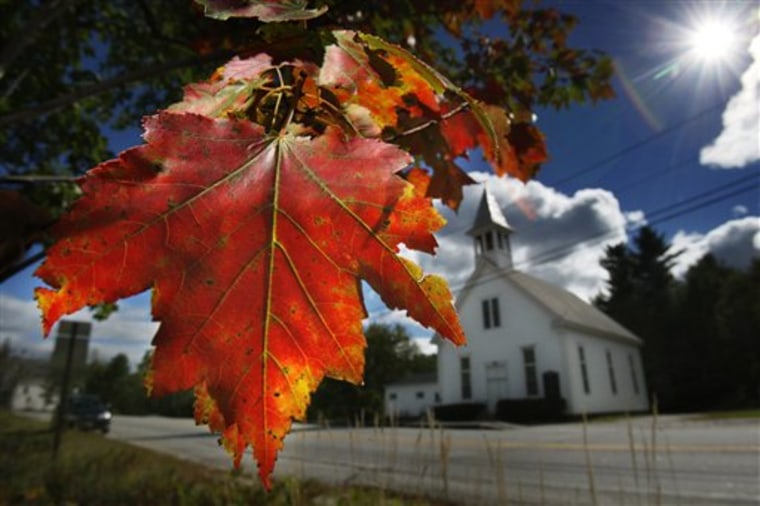Jon Bouton does his leaf-peeping from his car, traveling Vermont's bumpy back roads in a 2001 Geo Prizm.
When the sugar maples, ash and poplars begin to show their colors, the Windsor County forester sends e-mails to the state tourism office, describing where the colors are brightest and what roads to drive to see them. His counterparts in Vermont's other 13 counties do the same twice a week, their reports eventually combined into an online "foliage forecast."
Bouton, 59, is part of a small army of foresters, park rangers, volunteers and attraction operators in foliage-rich states whose observations point the way.
"If we're driving somewhere, we're looking," he said.
Fall foliage is a multimillion-dollar business for tour operators, inns, restaurants and attractions who cash in on the rush of camera-toting visitors. Nowhere is it more vibrant than in New England, where a predominance of maple trees produces a dazzling display of red, yellows, oranges and browns and everything in between.
In Vermont alone, visitors spend $374 million a year in the September-to-November season. Lucrative though it is, the fall isn't as big for the state as ski season and summertime, tourism department spokeswoman Erica Houskeeper said.
Finding color
Typically, the foliage season runs from the end of September to mid-October, when chlorophyll in the leaves breaks down because days are getting shorter and nights colder.
Forecasting the colors is not new, but the Internet has boosted its immediacy and given leaf lovers new tools for going where the color is. Visitors can get foliage forecasts from state-run telephone hotlines that advise where to go and online — in words, maps and photos.
In North Carolina, the state Division of Tourism's "Leaf Peepers" program puts forecasts online and on a telephone hotline beginning Sunday. In Tennessee, the Great Smoky Mountains Association posts a web page the observations of a volunteer. In Pennsylvania's Pocono Mountains, the regional visitors bureau posts color-coded maps online.
"The technology allows us to do quicker, more accurate foliage reporting, which is absolutely essential for our fall visitors," said Jeanne Curran, a spokeswoman for Maine Department of Conservation, which relies on park rangers for leaf reports.
The forecasts come from volunteer spotters who deliver reports about what roads to drive, which kinds of trees are turning and when the peak periods of color will be. Those, in turn, are posted on websites in words, photos and colored maps.
"Best Bets: Route 108 through Smugglers' Notch between Stowe and Cambridge is showing early color, as are Routes 242 and 100 near Jay Peak, Route 114 between Lyndonville and Canaan, and Route 2 near Danville," read part of the forecast from Vermont's tourism department this week.
Official 'leaf peepers'
New Hampshire, which gets observations from three dozen designated "leaf peepers" from chambers of commerce and lodging properties, offers foliage text alerts for those who want them, as does Massachusetts.
Among the eyes: "White Mountain Mike" Duprey, 58, a public relations representative and group tour coordinator for the White Mountain Attractions Association. Twice a week, he gives updates on his part of New Hampshire that are then incorporated into the state tourism department's foliage forecast.
While it's in his interest to report blazing colors, he says he never exaggerates.
"We really are honest, to a fault," he said. "We're more cautious, because we know — each one of us — that the worst thing would be to give a report that's more optimistic and then get someone up here saying, 'I read that foliage report and it wasn't anywhere near as colorful as they said.'"
Massachusetts uses park rangers who e-mail their reports twice a week.
"It's not based on predictions, it's based on actual observations," said Betsy Wall, executive director of the Massachusetts Office of Travel and Tourism.
Bouton, the Vermont forester, acknowledges he puts a positive spin on his reports — by not giving negative ones.
"I'm more likely to say nothing than I am give a negative report," he said. "But if I say this road should be a good place to take a look, it would be."
As for this year's foliage forecast, experts say the summer's hot, dry weather could make for more muted colors, an earlier start, both — or neither.
University of Vermont plant biologist Abby van den Berg, who has done research on leaf colors, said some data suggest a small amount of physiological stress can result in more brilliant colors.
"The real bottom line is that there's no great way to predict these things," she said. "It's pretty much impossible, especially over a large scale."
